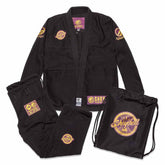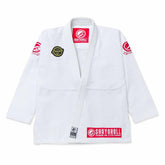Is BJJ Effective in a Street Fight? What You Should Know
In today’s world, self-defense is more important than ever. Many martial arts practitioners and everyday people alike are turning to Brazilian Jiu Jitsu (BJJ) as a practical and effective system of protection. But one burning question remains: Is BJJ effective in a street fight? The short answer is yes — but there is much more to unpack.
In this comprehensive guide, we will break down why Brazilian Jiu Jitsu is effective for street fights. This will show how BJJ compares to other martial arts in real-world scenarios and the role of Gi and No-Gi BJJ. And what every practitioner should know when applying BJJ outside the gym or dojo.
Understanding BJJ: The Art of Control and Submission
Brazilian Jiu Jitsu is a martial art and combat sport. It is focused on ground fighting and submission holds. BJJ is not like striking-based systems like boxing or Muay Thai. But BJJ emphasizes control, leverage and technique. Thus, enabling a smaller individual to neutralize a larger, more aggressive attacker.
At its core, BJJ teaches:
- Takedowns and clinches to bring an opponent to the ground
- Positional control like mount, side control, and back control
- Submissions such as joint locks and chokes
- Escapes and sweeps to reverse dangerous positions
Why Brazilian Jiu Jitsu Works in Street Fights
Let’s dive into the specific reasons why BJJ is one of the most effective martial arts in street fight scenarios:
1- Realistic Self-Defense Scenarios
Most street fights end up in a clinch or on the ground, especially when untrained individuals are involved. Brazilian Jiu Jitsu shines here because it starts where most fights end up. BJJ is not like some traditional martial arts that focus on stylized movement. BJJ teaches realistic, pressure-tested techniques that work in chaotic and unpredictable environments.
2- Control Without Excessive Damage
In a street fight, especially in situations involving legal consequences or multiple attackers, being able to control an aggressor without inflicting serious injury is invaluable. BJJ allows practitioners to neutralize threats using positional dominance or submissions. And all this is done without necessarily throwing punches or kicks.
This is ideal for:
- Law enforcement officers
- Security personnel
- Civilians who want to de-escalate without violence
3- Effectiveness Against Bigger Opponents
BJJ was developed so that a smaller person could defend themselves against a larger attacker. They can defend themselves by using leverage, angles and technique. This makes Brazilian Jiu Jitsu an ideal choice for women, children or anyone of smaller stature seeking practical self-defense training.
Gi vs No-Gi BJJ: Which One is Better for Street Fights?
One of the most debated topics in the BJJ world is the effectiveness of Gi vs No-Gi BJJ for real-world self-defense. Each has its pros and cons when applied to street fight scenarios.
Gi BJJ:
- Simulates real clothing — think of grabbing jackets, sleeves, collars
- Great for learning grip fighting and grip-breaking
- Builds strong fundamentals in control and technique
- However, in hot climates or casual street attire (like t-shirts or tank tops), some Gi grips may be hard to replicate.
No-Gi BJJ:
- Closer to real-world scenarios where the opponent may not wear grabbable clothes
- Faster pace with more focus on wrestling, clinch work and body control
- Emphasizes athleticism, timing, and grip-less control
Conclusion: For street fights, training both Gi and No-Gi BJJ is ideal. Gi builds strong technical base and precision. However, No-Gi prepares you for slippery, clothing-less self-defense situations.
Limitations of BJJ in a Street Fight
While Brazilian Jiu Jitsu is extremely effective, no martial art is perfect. Here are a few limitations you should consider:
1- Multiple Attackers
BJJ is designed for one-on-one encounters. If you are on the ground grappling with one person and a second attacker appears, you are at a serious disadvantage. In such scenarios, being on your feet and mobile is key.
2- Weapons
BJJ assumes an unarmed opponent. In street fights involving knives, guns or blunt objects, grappling becomes riskier. Specialized weapon-defense training should complement your BJJ practice.
3- Environment Hazards
A street is not a gym mat. Concrete, gravel, glass and obstacles can turn a simple takedown into a serious injury. Practicing safe takedowns and breakfalls is crucial if you plan to apply BJJ in real life.
How to Make BJJ More Street-Ready
To ensure your Brazilian Jiu Jitsu skills are street-effective, keep the following tips in mind:
1- Train for Self-Defense, Not Just Sport
Sport BJJ often starts from seated guard, ignores strikes and emphasizes points. For street readiness, train with strikes in mind, work on standing control and practice disengagement.
2- Drill Real-Life Scenarios
Practice BJJ while:
- Wearing street clothes
- Facing verbal aggression scenarios
- Escaping wrist grabs and clinches
3- Cross-Train in Striking
Even basic knowledge of boxing, Muay Thai or Krav Maga can help you defend yourself while standing, before engaging in grappling.
4- Situational Awareness is Key
The best self-defense is avoiding the fight altogether. BJJ gives you tools to defend yourself. But awareness, de-escalation and escape should always be your first priorities.
Real-World Examples of BJJ in Action
There are countless real-life videos and reports of Brazilian Jiu Jitsu practitioners safely subduing aggressive individuals. Using their skills, they have subdued individuals including MMA fighters, bouncers, police officers and regular civilians. These stories consistently showcase how technique beats brute strength. Moreover, how BJJ’s focus on control makes it uniquely suited for unpredictable street fights.
Conclusion: Is BJJ Effective in a Street Fight? Absolutely — But Train Smart
Brazilian Jiu Jitsu is one of the most effective martial arts for self-defense and street fight situations. All thanks to its emphasis on control, submissions and technique over brute force. It does not matter whether you train in Gi or No-Gi BJJ. Both styles offer valuable tools for real-world combat. However, no system is flawless. So, complement your BJJ with situational awareness, striking basics and weapon defense knowledge.
You are serious about protecting yourself or your loved ones! Start training BJJ today — not just as a sport, but as a practical, life-saving skillset.
Bonus: What to Wear for Street-Effective BJJ Training
If you are preparing for real-world encounters, consider training in:
- No-Gi rash guards and shorts
- Everyday clothes like jeans and hoodies (occasionally)
- Durable BJJ Gis that simulate jacket grips
Shop high-quality BJJ Gi and No-Gi gear from trusted brands that support self-defense training.
Frequently Asked Questions (FAQs)
Q: Can BJJ work against a bigger and stronger attacker?
A: Yes, BJJ was designed specifically for smaller individuals to defeat larger ones using leverage and technique.
Q: Is it better to train Gi or No-Gi for street fights?
A: Ideally, both. Gi helps build solid technique, while No-Gi better simulates street conditions.
Q: Should I train BJJ for self-defense or sport?
A: Sport BJJ is great. But make sure to include self-defense-specific drills and strategies in your training.



















